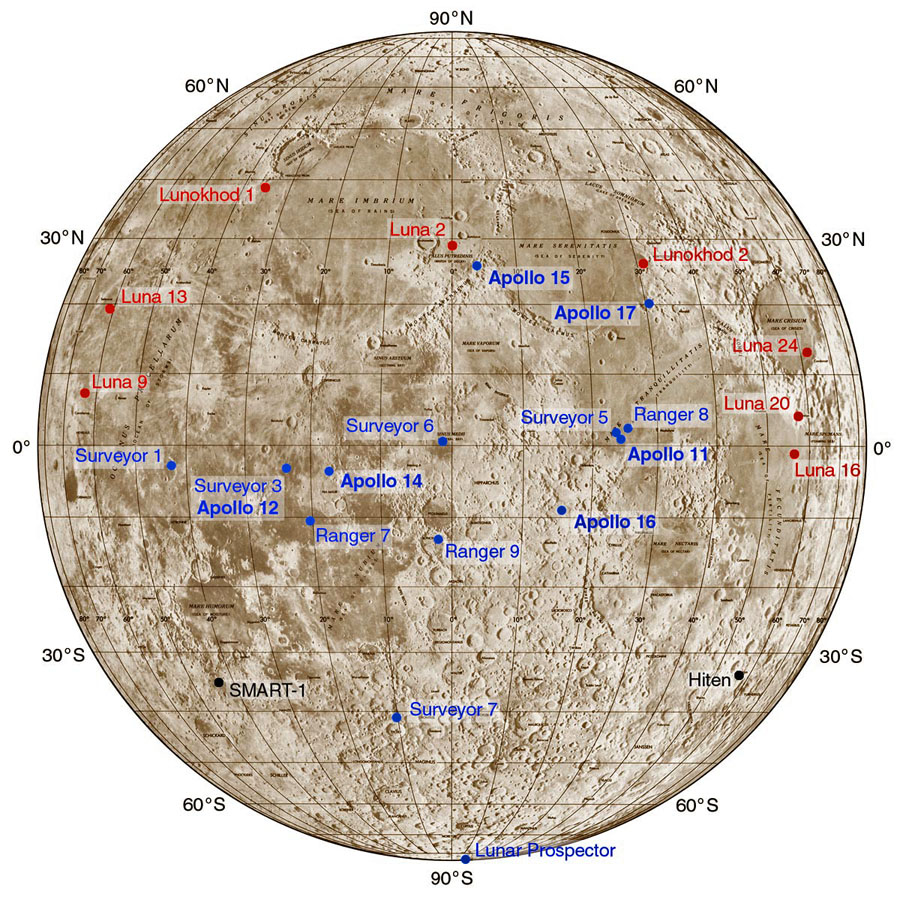LPOD May 17, 2008
WHERE HAVE ALL THE LANDERS GONE?

image by Philip J Stooke, London, Ontario, Canada
Exploration of the Earth's continents was largely conducted by sailing ships, leading to landing points being along ocean shores. Ships to the Moon also preferentially landed near shorelines, but on the "wet" side where the maria were hoped to be smoother and safer than the highly cratered land side. Minimum energy flight paths also kept landing sites clustered near the equator. But over time, experience and scientific enticement led to forays away from the equator (Apollo 15 & 17) and the maria (Apollo 16). As I look at all the other red and blue names I realize how little we truly learned from them. The Rangers gave the first high res views of the lunar surface, teaching that craters occurred at all scales, but little more. Surveyors provided very local looks at the surface and rough chemical analyses, but ambiguity made firm conclusions problematic. The Soviet Lunokhods were the most bizarre looking contraptions ever sent to the Moon. They were robust though and explored tens of kilometers, but taught us very little. The Luna sample return landers were technologically dazzling (when they worked) and the samples provided information on surface rock ages and compositions, But the lack of knowledge of exactly where they landed and what the local geology was deprived the samples of significant contextual information. And more so than the Apollo sites, the Luna ones were governed by orbital mechanics and chance landings, rather than scientific interest. While they were in orbit SMART-1 and Lunar Prospector were effective explorers, but their crash landings led to negligible scientific results. So we have lots of names scattered across the map, but most of what we know of lunar composition, ages and structure came from the six Apollos that brought back hundred of kilograms of intelligently selected samples and left sophisticated geophysical stations.
Chuck Wood
Technical Details
A larger image and Phil's comments are here.
Related Links
Phil's website
COMMENTS
To post comments regarding this LPOD, please click here and enter your text in the space below. You will not see the Edit tab unless you register for the wiki. Please do not edit the LPOD itself!
(1) Strange to say, there are thirty wheels on the lunar surface!
- Lunokhod 1: Eight wheels.
- Lunokhod 2: Eight wheels.
- Apollo 14's Modularized Equipment Transporter (MET): Two wheels.
- Apollo 15's Lunar Roving Vehicle (LRV): Four wheels.
- Apollo 16's Lunar Roving Vehicle (LRV): Four wheels.
- Apollo 17's Lunar Roving Vehicle (LRV): Four wheels.
-- Danny Caes.
(2) Phillip, very nice on the above -- and have a query. When I was researching the locations of some of the ~30 or so crafts that landed on the lunar surface (intentionally and unintentionally) for my map, I came across a site that showed images of some of the impacts sites of several of them. The author (???) had compiled some wonderful shots (some showing actual impact ejecta rays etc.,) and he also gave a brief description on them, however, having mislayed the site -- foolishly -- and having tried in vain to find it again, would you happen to know anyone who has these data, or, in fact, the site itself? Just another note, when trying to get the exact location of the crashed crafts for the map, I came across conflicting data -- some giving certain lat/long coordinates but others giving different. For example, with Luna 5, I just couldn't get the exact location site for it; some saying 31S, 8W (the best guessed location so far I'm told by a NASA member) while others put it at 8.17N, 23.43W. Given that -- understandabley -- that we just don't have enough data, I hope that in the near future the series of lunar landers and orbiters will in some way clarify the above. John -- www.moonposter.ie